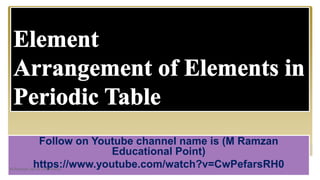
Element and arragnemnt of elements in periodic table
- 1. Follow on Youtube channel name is (M Ramzan Educational Point) https://www.youtube.com/watch?v=CwPefarsRH0M.Ramzan (M.Sc Chemistry)
- 2. Old Definition “Element is a substance that can not be broken down into simpler units by ordinary chemical process.” Element M.Ramzan (M.Sc Chemistry)
- 3. In past only nine elements were known at that time. These were carbon, gold, silver, tin, mercury, lead, copper, iron and sulphur. M.Ramzan (M.Sc Chemistry)
- 4. “It is a substance made up of same type of atoms, having same atomic number and cannot be decomposed into simple substance by ordinary chemical means.” M.Ramzan (M.Sc Chemistry)
- 5. At the end of nineteenth century only 63 elements were discovered. Now 118 elements have been discovered, out of which 92 are naturally occurring. M.Ramzan (M.Sc Chemistry)
- 6. Elements occurs in free or combined both states. In nature elements are present in earth’s crust, ocean and air. Natural occurrence by weight % of some major elements is given below Earth’s Crust Ocean Atmosphere Oxygen 47% Oxygen 86% Nitrogen 78% Silicon 28% Hydrogen 11% Oxygen 21% Aluminium 7.8% Chlorine 1.8% Argon 0.9% M.Ramzan (M.Sc Chemistry)
- 7. Elements may be solid, liquid and gas. 80% elements exist as solid such as gold, silver, copper, zinc, carbon etc. Mercury and bromine exist as liquid. A few elements exist as gases such as nitrogen, oxygen, chlorine and hydrogen. M.Ramzan (M.Sc Chemistry)
- 8. Elements are also classified as Metals, Non-metals and Metalloids. Metals: “An element which is good conductor of heat and electricity, malleable and ductile, has a shiny surface and always forms positive ions by losing electrons is called Metal.” 80% elements are metals. Examples: sodium, copper, silver, gold, iron etc. M.Ramzan (M.Sc Chemistry)
- 9. Non-Metals: “An element which is non conductor of heat and electricity, not malleabe and not ductile, not lustrous and always forms negative ion by gaining electrons is called Non- Metal. Example: Carbon, sulphur, phosphorus, fluorine, chlorine etc.
- 10. Metalloids: “An element having physical and chemical properties of both metals and non-metals is called Metalloid.” Example: only seven elements are metalloids. They are boron, silicon, germanium, antimony, tellurium and astatine. M.Ramzan (M.Sc Chemistry)
- 11. “Two or more atoms of an element having the same atomic number but different mass numbers are called isotopes.”
- 12. Isotopes of Carbon Carbon has three isotopes Carbon -12 ( 𝟔 𝟏𝟐 𝑪) ,carbon-13( 𝟔 𝟏𝟑 𝑪) and carbon-14 ( 𝟔 𝟏𝟒 𝑪 ). Carbon 14 is radioactive.
- 13. Modern Periodic Law In 1913, H. Moseley discovered a new property of the elements which is atomic number. Atomic number is more fundamental property than atomic mass because atomic number of an elements is fixed. All isotopes have the same atomic number. Also no two elements can have the same atomic number.
- 14. Modern periodic law can be stated as: “The properties of elements are periodic function of their atomic numbers.”
- 15. Modern Periodic Table The basis of classification of elements in the modern periodic table is atomic number and modern periodic law.
- 16. Modern Periodic Table Atomic number of an elements is more fundamental property than atomic mass in two respects. 1. It increases regularly from element to element. 2. It is fixed for every element and its isotopes. Different atoms of the same element have the same atomic number.
- 18. Electronic configuration “The distribution of electrons in various subshells according to their increasing energy is called electronic configuration.”
- 19. In filling the subshells electrons enter in lower energy subshell first. The increasing order in which the electrons will enter into subshells is; 1s, 2s, 2p, 3s, 3p, 4s, 3d, 4p, 5s, 4d, 5p, 6s, 4f, 5d, 6p, 7s The filling of subshells can be represented as follows. “n” 1 2 3 4 Shells/ Energy Level K L M N
- 20. Maximum number of electron in any shell Maximum number of electrons in any shell can be calculated by formula 2n2 For K n=1, the number of electrons in K shell = 2n2 = 2(1)2 = 2 For L n=2, the number of electrons in L shell = 2n2 = 2(2)2 = 8 For M n=3, the number of electrons in M shell =2n2 = 2(3)2 = 18 For N n=4, the number of electrons in N shell = 2n2 = 2(4)2 = 32
- 21. Number of Subshells in a shell “n” Shell Subshell 1 K “s” 2 L “s , p” 3 M “s, p, d “ 4 N “s, p, d, f “ M. Ramzan (M.Sc. Chemistry)
- 22. Maximum number of electron in a subshells “s” subshells can accommodate a maximum of 2 electrons. “p” subshells can accommodate a maximum of 6 electrons. “d” subshells can accommodate a maximum of 10 electrons. “f” subshells can accommodate maximum of 14 electrons. M. Ramzan (M.Sc. Chemistry)
- 23. Examples 1H = 1s1 2He = 1s2 3Li = 1s2 , 2s1 4Be = 1s2 , 2s2 5B = 1s2 , 2s2 , 2p1 6C = 1s2 , 2s2, 2p2 7N = 1s2 , 2s2, 2p3 8O = 1s2 , 2s2, 2p4 9F = 1s2 , 2s2, 2p5 10Ne = 1s2 , 2s2, 2p6 11Na = 1s2 , 2s2, 2p6 , 3s1 12Mg = 1s2 , 2s2 , 2p6 , 3s2 13Al = 1s2 , 2s2 , 2p6 , 3s2 , 3p1 14Si = 1s2 , 2s2 , 2p6 , 3s2 , 3p2 15P = 1s2 , 2s2 , 2p6 , 3s2 , 3p3 16S = 1s2 , 2s2 , 2p6 , 3s2 , 3p4 17Cl = 1s2 , 2s2 , 2p6 , 3s2 , 3p5 18Ar = 1s2 , 2s2 , 2p6 , 3s2 , 3p6 19K = 1s2 , 2s2 , 2p6 , 3s2 , 3p6 , 4s1 20Ca = 1s2 , 2s2 , 2p6 , 3s2 , 3p6 , 4s2